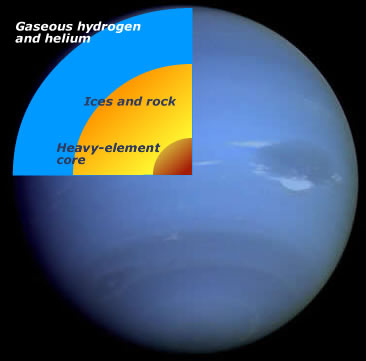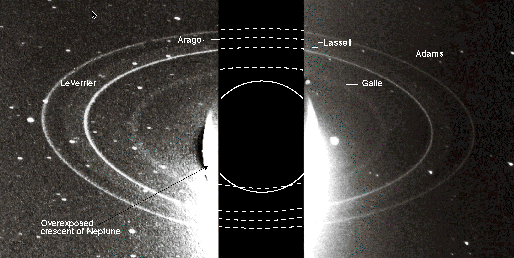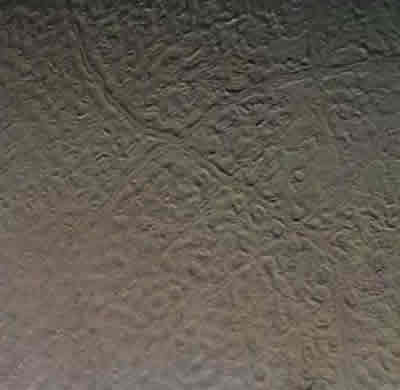Neptune
547-552
Neptune has several distinctions to its credit. It is the first planet that found by prediction! By the early part of the 19th century astronomers had noted peculiarities in the orbit of Uranus that suggested the presence of a nearby but unseen planet. In 1846 the astronomer Galle found the planet working from predicted positions made independently by the British mathematician Adams and the French mathematician LeVerrier. A second distinction is that Neptune is the most distant of the solar systems 8 major planets.
Basic Facts
|
 |
||||||||||||||||||||
| Figure 18.28 Voyageur 2 image of Neptune in 1989. (image courtesy NASA) | |||||||||||||||||||||
The Interior and Atmosphere
Neptune likely consists of a small, rocky core surrounded by a slushy mixture of ices. The atmosphere is similar to that of Uranus but with a higher concentration of methane. Methane has strong absorption bands in the red part of the spectrum and this means that the light reflected back from the planet will be deficient in red photons - it will look blue! One intriguing possibility is that both Uranus and Neptune may be rich in diamonds! The methane rich atmospheres may be source. Methane is CH4 - a carbon atom surrounded by 4 hydrogen atoms. Udder high pressure the Carbon atoms can be squeezed together to form a carbon crystal - diamond! One surprising aspect of Neptune's atmosphere is the activity! The summer 1989 Voyageur images showed a large dark spot and several bright white cloud layers. More recent Hubble images show no dark spot but new cloud formations are present. Neptune receives even less energy from the sun than Uranus and this has led to speculation that Neptune may be generating a small amount of energy from within which helps drive convection in the outer envelope of the planet. |
 |
| Figure 18.29 Internal structure of Neptune |
Example 18.9 Why does cloud activity on Neptune suggest that there may be an internal source of energy?
Solution: Cloud activity usually suggests convective motion in the atmosphere. Uranus shows very little atmospheric activity so the amount of activity in Neptune's atmosphere came as a surprise. Sine Neptune receives less than 1/2 as much solar energy as does Uranus it suggests that there may be a small amount of internal energy driving the convection. As well, Neptune has about 50% more methane which is an effective greenhouse gas. Perhaps this is helping to trap some of the Sun's feeble rays and providing a warmer atmosphere.
The Magnetic Field on Neptune
Neptune has a moderate strength magnetic field that is not aligned with its rotational axis. This suggests that Neptune's field is produced in a convective zone closer to the surface of the planet. The two main ingredients for a dynamo-driven magnetic field exist on Neptune:
- high rotation rate (17 hours)
- electrically conducting interior - ammonia dissolved in a slushy water mixture should be able to conduct electricity
This means that Neptune is surrounded by a magnetosphere and, faint aurora have been observed on Neptune.
Neptune's Moons and Ring System
Neptune has two major moons; Triton and Nereid and at least a dozen tiny moons. Nereid is small (about 1/10th the size of our moon) and travels in a highly elliptical orbit. Triton is larger (about 80% the size of our moon) but is traveling in a backwards or retrograde orbit!
 |
|
| Figure 18.30 Voyageur 2 image of Triton. (Image courtesy NASA) | Figure 18.31 High resolution Voyageur 2 image of surface of Triton. (Image courtesy NASA) |
Figures 18.30, 18.30 show Triton to be a cold, icy world. The close up image in 18.31 however reveals an intricate surface of folds and relatively few craters. This suggests that the moon may have been geologically active in the past million years. Craters would have been filled in by flooding from liquid water coming from beneath the crust. It is possible that "water volcanoes" perhaps driven by the heat produced by radioactive decay of elements in the core of the moon could still be providing enough heat to support volcanic activity. At a temperature of 37K (-236 C) Triton is cold with a very thin nitrogen and methane atmosphere.
The backward orbital motion of Triton suggests that it and Neptune may have encountered a violent collision early in the formation of the planetary system.
| Neptune also supports a thin ring system very similar to Uranus' rings. One distinguishing feature of Neptune's rings however, is the effect that the small moon Galatea has on the outer rings. Galatea travels on a highly elliptical orbit and this causes clumps to form which look like gaps or breaks in the outer ring. |  |
| Figure 18.32 Voyageur 2 image of the Neptunian ring system. (Image courtesy NASA) |
Example 18.10 Why do astronomers think that planetary rings formed after their parent planets and are likely still "forming"?
Solution: The rings around the Jovian planets are made up of ices. These would not have been able to condense around the proto planets because the environment would have been too hot. After the planets and their moons formed, collision with the moons would produce a steady supply of small, cold ice particles. It is also possible that entire moons could be shredded as they crossed the Roche limits for the planets. Since impacts still occur in the soar system it is reasonable to conclude that rings are still forming.
Practice
- Why do astronomers suspect that Neptune has an internal source of heat?
- Why are both Uranus and Neptune blue-green in colour with Neptune being a deeper blue?
- What evidence from the moons Nereid and Triton suggest that Neptune and its moons underwent a violent interaction in the distant past?
- Why do the moons of the outer planets tend to have atmospheres even though some of them are smaller than our own moon? What are the conditions that must hold for an atmosphere to exist around a body?

To understandNeptune as an Outer Solar System planet
Chp 24-2
![]()

Planetary rings exist because of the influence of moons - especially shepherding moons.
 The rings aorunf Neptune are named after astronomers with the most prominent rings being the Adams, LeVerrier and Galle rings.
The rings aorunf Neptune are named after astronomers with the most prominent rings being the Adams, LeVerrier and Galle rings.
